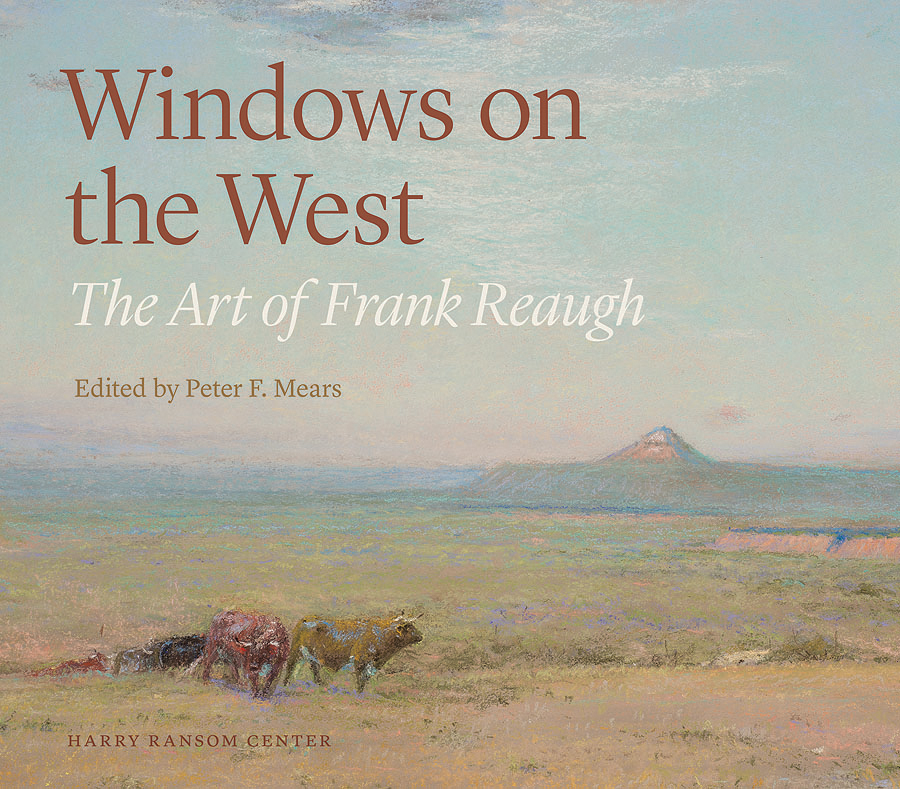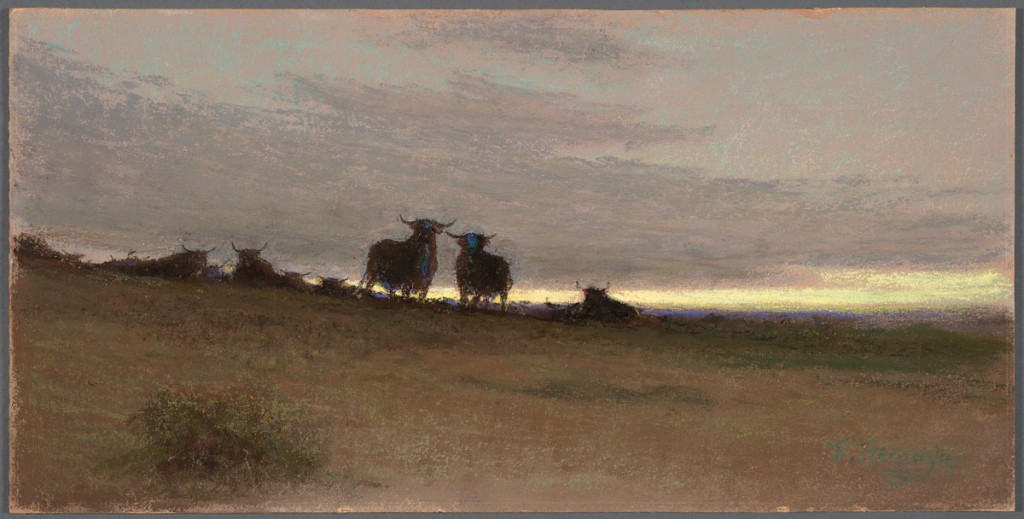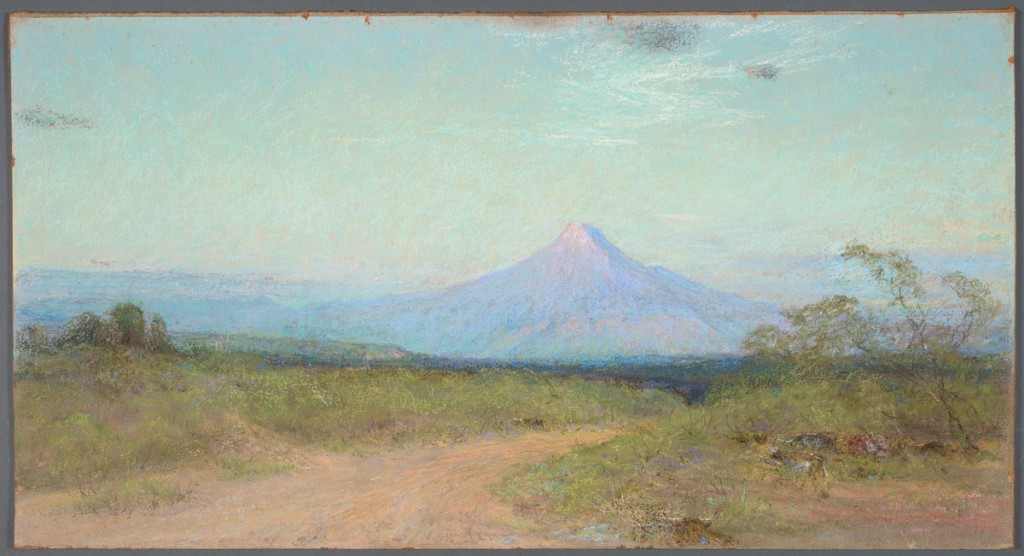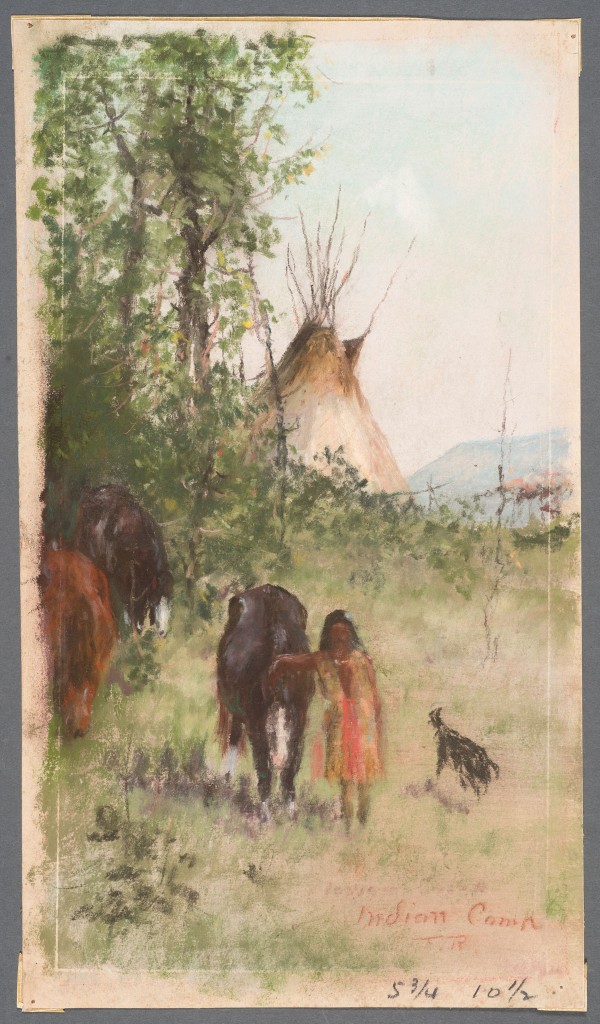
From August 4 through November 29, 2015, the Harry Ransom Center hosts the exhibition Frank Reaugh: Landscapes of Texas and the American West. The showcase displays over 100 artworks by renowned artist Frank Reaugh (pronounced “Ray”). To complement the exhibition, a companion book is available titled Windows on the West, The Art of Frank Reaugh, edited by Curator of Art Peter F. Mears. The excerpt below is Mears’s introduction to the book, titled “Rediscovering the Art of Frank Reaugh.” In it, he describes Reaugh’s life, vision, and legacy as one of Texas’s most iconic artists.

Windows on the West: The Art of Frank Reaugh
(University of Texas Press and Harry Ransom Center)
Edited by Ransom Center Art Curator Peter Mears
The genesis of the Harry Ransom Center’s exhibition Frank Reaugh: Landscapes of Texas and the American West and this companion publication dates to 1937 when Frank Reaugh, well into the autumn of his long and distinguished career, donated a portion of his art collection to The University of Texas at Austin. For more than a decade he had searched for an institution that would preserve and exhibit a group of key artworks that he had held back from the market.
In addition to a manuscript component, the donation consisted of three main parts. First were Reaugh’s early monochrome landscapes and studies of wild animals. The second part, and by far the largest, included early pen-and-ink studies, pastel color studies, and field sketches all prized today for their mesmerizing quality. He often consulted these small, delicately rendered artworks of remote sites across Texas, from Tule Canyon and the Caprock in the Panhandle to the mountains and canyons of Big Bend and beyond, in the creation of his larger works, which were the third part of his donation. These are large landscape paintings skillfully crafted in the studio in oil and pastel. They primarily feature the Texas Longhorn, a lifelong subject of study for the artist and the main protagonist in his visual narrative of the West. “It is my hope,” Reaugh said just before donating his collection, “that my pictures portraying those times, aside from any artistic merit that they may possess, will tell their story, and will be preserved because of historical value; for the steer and the cowboy have gone, the range has been fenced and plowed, and the beauty of the early days is but a memory.”[i] Today, his hope has been realized.

The Coming Herd–Morning, undated, pastel on cardboard, 12 3/16 x 24 inches.
As a witness to the cattle drives of the 1880s and the trail drivers’ way of life, Reaugh gave his artworks an authoritative quality that will undoubtedly sustain his well-deserved reputation as the painter of the Texas Longhorn for many years to come. Yet, Frank Reaugh was more—far more—than simply a cattle painter. By the time he deeded his collection to the University of Texas and “the people of the Southwest” in 1937, his reputation as one of the region’s leading pioneer artists was firmly secured and had even expanded to include such titles as dean, mentor, inventor, and by example of the gift of his collection, cultural benefactor.[ii]
In donating his collection, Reaugh had the foresight to publish a small catalog, Paintings of the Southwest, that included illustrations and comments on those works that he felt were the most memorable. His candid observations provide insight today into not only how he developed as an artist but also why he felt his collection, spanning more than five decades, held great historical value. Many of the artworks in Reaugh’s original gift to The University of Texas at Austin are listed in the catalog, and his comments about them are placed among this book’s plate captions.

Unknown photographer.
Image courtesy of Jerry Bywaters Collection on Art of the Southwest, Bywaters Special Collections, Hamon Arts Library, Southern Methodist University, Dallas, Texas.
Reaugh’s gift of artworks and archival materials arrived at The University of Texas at Austin after he died in 1945 and were housed in Battle Hall, where the Archives department and the Texas Collection Library, as well as the offices of the Texas State Historical Association, were located. Reaugh’s art remained on view there intermittently until 1964. After the trustees of Reaugh’s estate, who were former students and friends, raised concerns about the visibility of his work, a large selection of Reaugh’s paintings and pastels went on exhibit in the University’s Flawn Academic Center. In 1966 University officials agreed to a transfer of artworks with the Panhandle-Plains Historical Museum (PPHM) in order to balance the number of Reaugh’s more significant paintings and pastel studies held in both collections. A portion of Reaugh’s collection that was not part of his original gift was distributed to the Museum of Texas Tech University (later transferred to Texas Tech’s National Ranching Heritage Center [NRHC]). Reaugh’s manuscripts remained at what is now the Dolph Briscoe Center for American History. The rest of his collection, which consists of 217 ink studies, pastels, and oils, was entrusted to the Harry Ransom Center, where the works have been treated and preserved by the Center’s conservation department. One of the primary goals of the exhibition and book is to reunite Reaugh’s original gift and include it along with the other works listed in his catalog.

Margaret’s Peak, circa 1933, pastel on Masonite, 16 1/8 x 29 15/16 inches.
Reaugh’s long life was bookended by the American Civil War and World War II. He witnessed this country’s dramatic transformation from a rural, agricultural-based society to an urban-centered powerhouse. Reaugh embraced science and new technologies with an open mind and an entrepreneurial spirit, filing novel patents for an easel for plein air painting and pumps and cooling devices for internal-combustion engines, though he sometimes lamented the consequences of the latter’s unbridled effect upon the environment. Reaugh proudly mentored some of Texas’s most gifted artists of his era, who in turn would forge a new regional identity. But his determined focus on the historic past eventually strained the relationship between him and his younger students. Unmoved by the Modernist currents that swept through the art world, Reaugh remained focused on producing artwork that would “preserve for future generations a vision of the old-time Texas cattle and their environment as they were in the days of the open range.”[iii] Art, he felt, should be not only authentic but purposeful: “Study art not to do but to know,” he once wrote, “then it may be that what you do is worthwhile.”[iv] Today, 70 years after his passing, Reaugh’s paintings function both as historical documents and as transcendent works of art. That Reaugh chose to emphasize the historical subjects in his pictures rather than “any artistic merit that they may possess” should not deter us from reconsidering the inherent beauty embedded within his artwork.
This publication includes more than 100 images created between 1880 and 1938 that together exemplify Reaugh’s life’s work. The paintings, pastels, and archival materials comprising Reaugh’s original gift anchor the book and exhibition. These items, drawn from the collections of the Harry Ransom Center and Dolph Briscoe Center for American History are complemented by key works selected from public and private collections across Texas. Together, they trace the full arc of his career. The Harry Ransom Center is particularly indebted to the Panhandle-Plains Historical Museum at West Texas A&M University in Canyon and the National Ranching Heritage Center at Texas Tech University in Lubbock for the loan of their collections of Frank Reaugh’s artworks.

Indian Camp, circa 1883, pastel on paper, 11 13/16 x 6 11/16 inches
We are pleased to have Ron Tyler, Michael R. Grauer, Rebecca E. Lawton, B. Byron Price, Susie Kalil, and Kenneth M. Grant as contributors to this book. Their research and thoughtful essays bring Frank Reaugh’s life and work back into focus for the twenty-first-century reader to discover with newfound appreciation. We hope their insights will encourage others to add to the ongoing conversation about Frank Reaugh taking place beyond this book. Together, this book and exhibition build on the momentum generated over the past two decades by an important circle of curators, scholars, and collectors who have worked hard to elevate Frank Reaugh to a place of greater prominence beyond the regional stage, while fulfilling his wish of preserving his work and his story.[v]
[i] Frank Reaugh, Biographical (Dallas: Self-published, 1936). Reaugh wrote his autobiography at his studio, El Sibil, in December 1936, about one year before donating his collection to The University of Texas at Austin.
[ii] Frank Reaugh Papers, Dolph Briscoe Center for American History, The University of Texas at Austin.
[iii] Ibid.
[iv] Frank Reaugh, To My Parents (Dallas: Self-published, n.d.). Frank Reaugh Papers, Panhandle-Plains Historical Museum, Canyon, Texas.
[v] The last three decades have seen a growing interest in Reaugh’s life and work. That began with the first fully illustrated hardback book on Frank Reaugh, Donald L. Weismann’s Frank Reaugh: Painter to the Longhorns (College Station: Texas A&M University Press, 1985). Small surveys followed over the years that included the Ransom Center’s 1997 exhibition Sightings and Weather Prophets: The West Texas Landscape of Frank Reaugh, and the 2011 exhibition, Frank Reaugh: Master of Pastels and the Plains of Texas, organized by the College of Arts & Sciences, the University of North Texas in Denton. The Panhandle-Plains Historical Museum in Canyon continues to maintain a gallery and archive dedicated to their Frank Reaugh collection.